Report on Continuing Professional Development (CPD)
VerifiedAdded on 2022/02/26
|18
|4022
|29
AI Summary
Continuing Professional Development (CPD) is the process of acquiring professional skills and knowledge through interactive, participatory, or self-directed learning. It enables learners to build their professional competencies proactively through accredited learning or self-directed learning approaches. CPD refers to any activity, official or informal, that aids in the development of your skills and knowledge, as well as the enhancement of your professional practice.
Contribute Materials
Your contribution can guide someone’s learning journey. Share your
documents today.
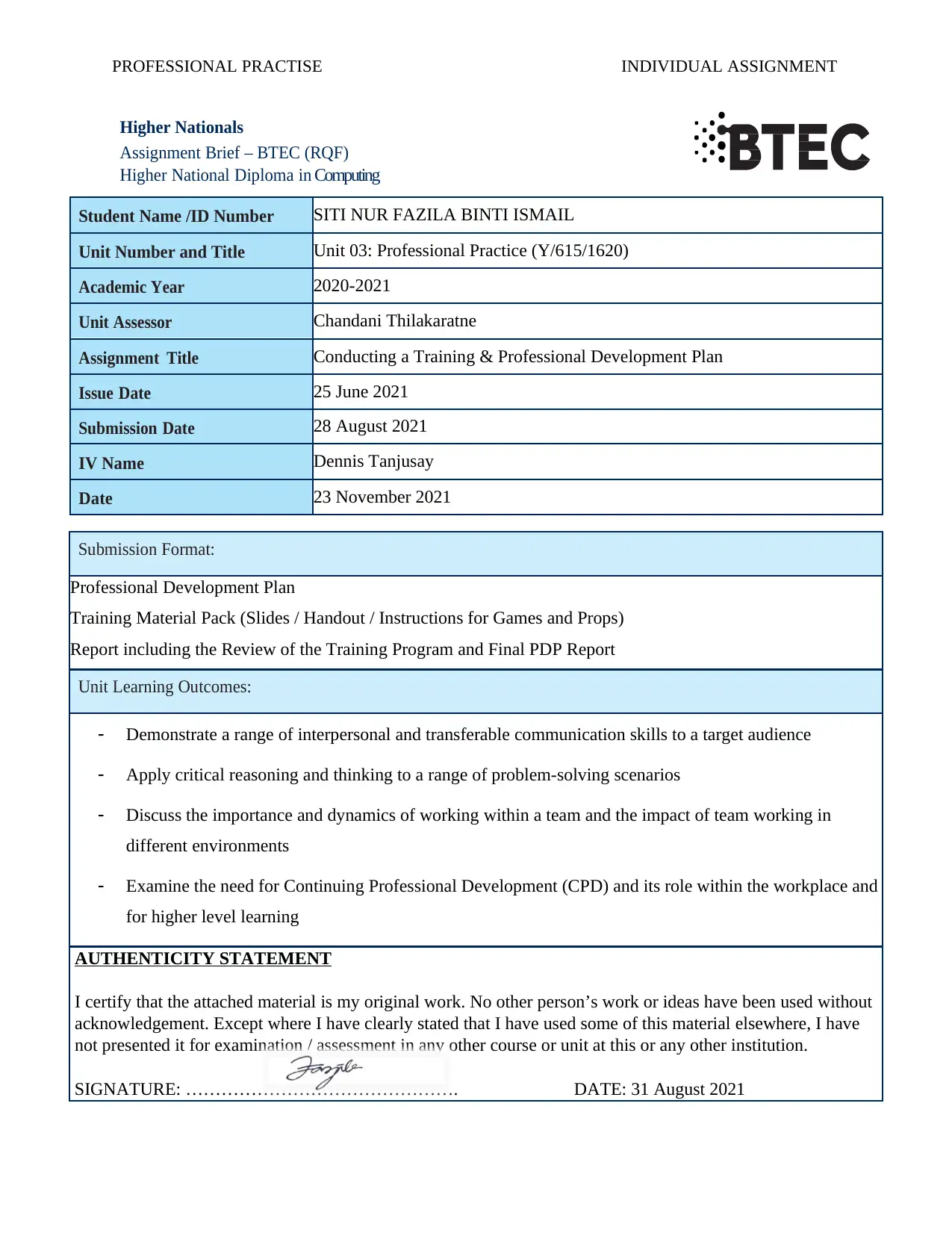
PROFESSIONAL PRACTISE INDIVIDUAL ASSIGNMENT
Higher Nationals
Assignment Brief – BTEC (RQF)
Higher National Diploma in Computing
Student Name /ID Number SITI NUR FAZILA BINTI ISMAIL
Unit Number and Title Unit 03: Professional Practice (Y/615/1620)
Academic Year 2020-2021
Unit Assessor Chandani Thilakaratne
Assignment Title Conducting a Training & Professional Development Plan
Issue Date 25 June 2021
Submission Date 28 August 2021
IV Name Dennis Tanjusay
Date 23 November 2021
Submission Format:
Professional Development Plan
Training Material Pack (Slides / Handout / Instructions for Games and Props)
Report including the Review of the Training Program and Final PDP Report
Unit Learning Outcomes:
Demonstrate a range of interpersonal and transferable communication skills to a target audience
Apply critical reasoning and thinking to a range of problem-solving scenarios
Discuss the importance and dynamics of working within a team and the impact of team working in
different environments
Examine the need for Continuing Professional Development (CPD) and its role within the workplace and
for higher level learning
AUTHENTICITY STATEMENT
I certify that the attached material is my original work. No other person’s work or ideas have been used without
acknowledgement. Except where I have clearly stated that I have used some of this material elsewhere, I have
not presented it for examination / assessment in any other course or unit at this or any other institution.
SIGNATURE: ………………………………………. DATE: 31 August 2021
Higher Nationals
Assignment Brief – BTEC (RQF)
Higher National Diploma in Computing
Student Name /ID Number SITI NUR FAZILA BINTI ISMAIL
Unit Number and Title Unit 03: Professional Practice (Y/615/1620)
Academic Year 2020-2021
Unit Assessor Chandani Thilakaratne
Assignment Title Conducting a Training & Professional Development Plan
Issue Date 25 June 2021
Submission Date 28 August 2021
IV Name Dennis Tanjusay
Date 23 November 2021
Submission Format:
Professional Development Plan
Training Material Pack (Slides / Handout / Instructions for Games and Props)
Report including the Review of the Training Program and Final PDP Report
Unit Learning Outcomes:
Demonstrate a range of interpersonal and transferable communication skills to a target audience
Apply critical reasoning and thinking to a range of problem-solving scenarios
Discuss the importance and dynamics of working within a team and the impact of team working in
different environments
Examine the need for Continuing Professional Development (CPD) and its role within the workplace and
for higher level learning
AUTHENTICITY STATEMENT
I certify that the attached material is my original work. No other person’s work or ideas have been used without
acknowledgement. Except where I have clearly stated that I have used some of this material elsewhere, I have
not presented it for examination / assessment in any other course or unit at this or any other institution.
SIGNATURE: ………………………………………. DATE: 31 August 2021
Secure Best Marks with AI Grader
Need help grading? Try our AI Grader for instant feedback on your assignments.
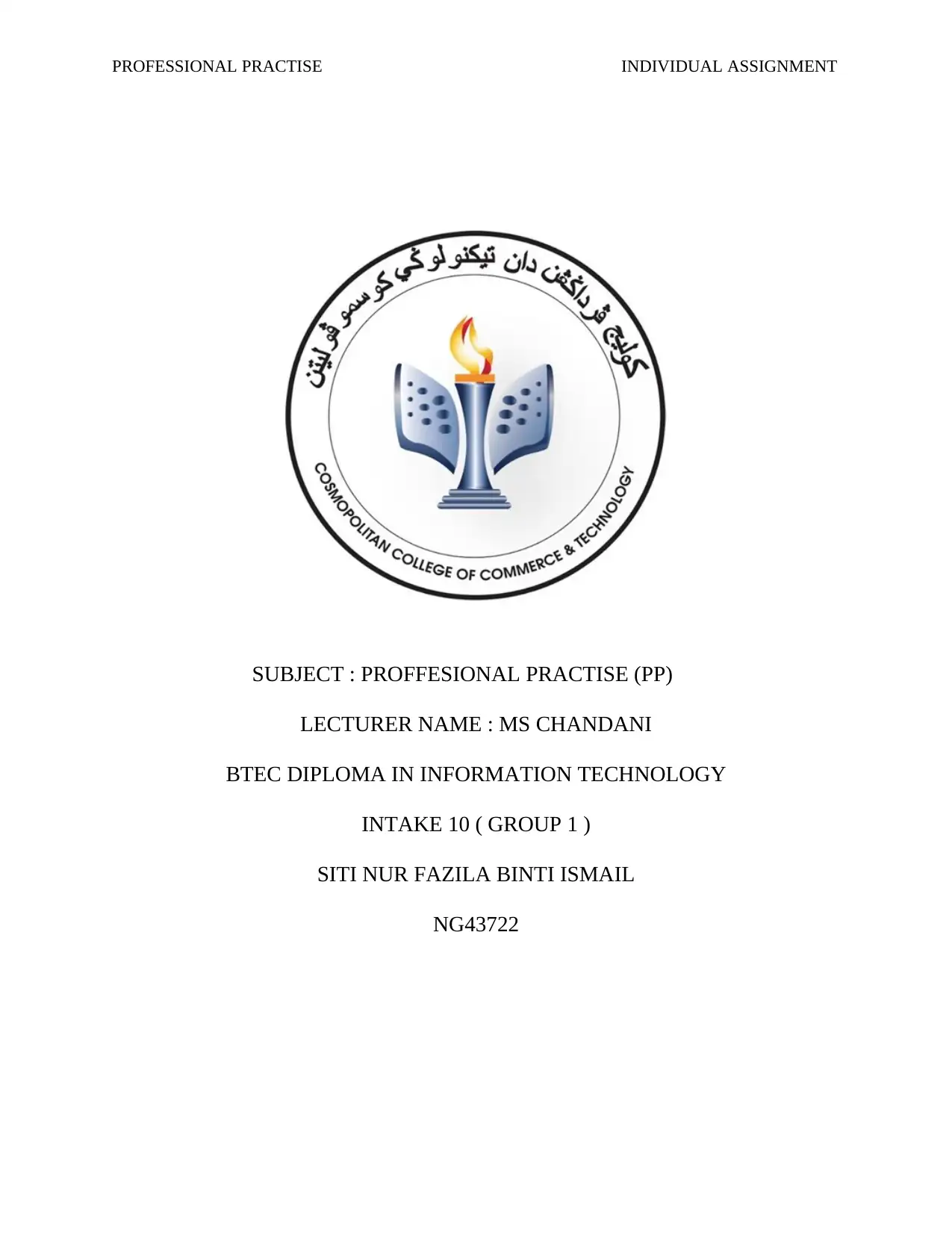
PROFESSIONAL PRACTISE INDIVIDUAL ASSIGNMENT
SUBJECT : PROFFESIONAL PRACTISE (PP)
LECTURER NAME : MS CHANDANI
BTEC DIPLOMA IN INFORMATION TECHNOLOGY
INTAKE 10 ( GROUP 1 )
SITI NUR FAZILA BINTI ISMAIL
NG43722
SUBJECT : PROFFESIONAL PRACTISE (PP)
LECTURER NAME : MS CHANDANI
BTEC DIPLOMA IN INFORMATION TECHNOLOGY
INTAKE 10 ( GROUP 1 )
SITI NUR FAZILA BINTI ISMAIL
NG43722
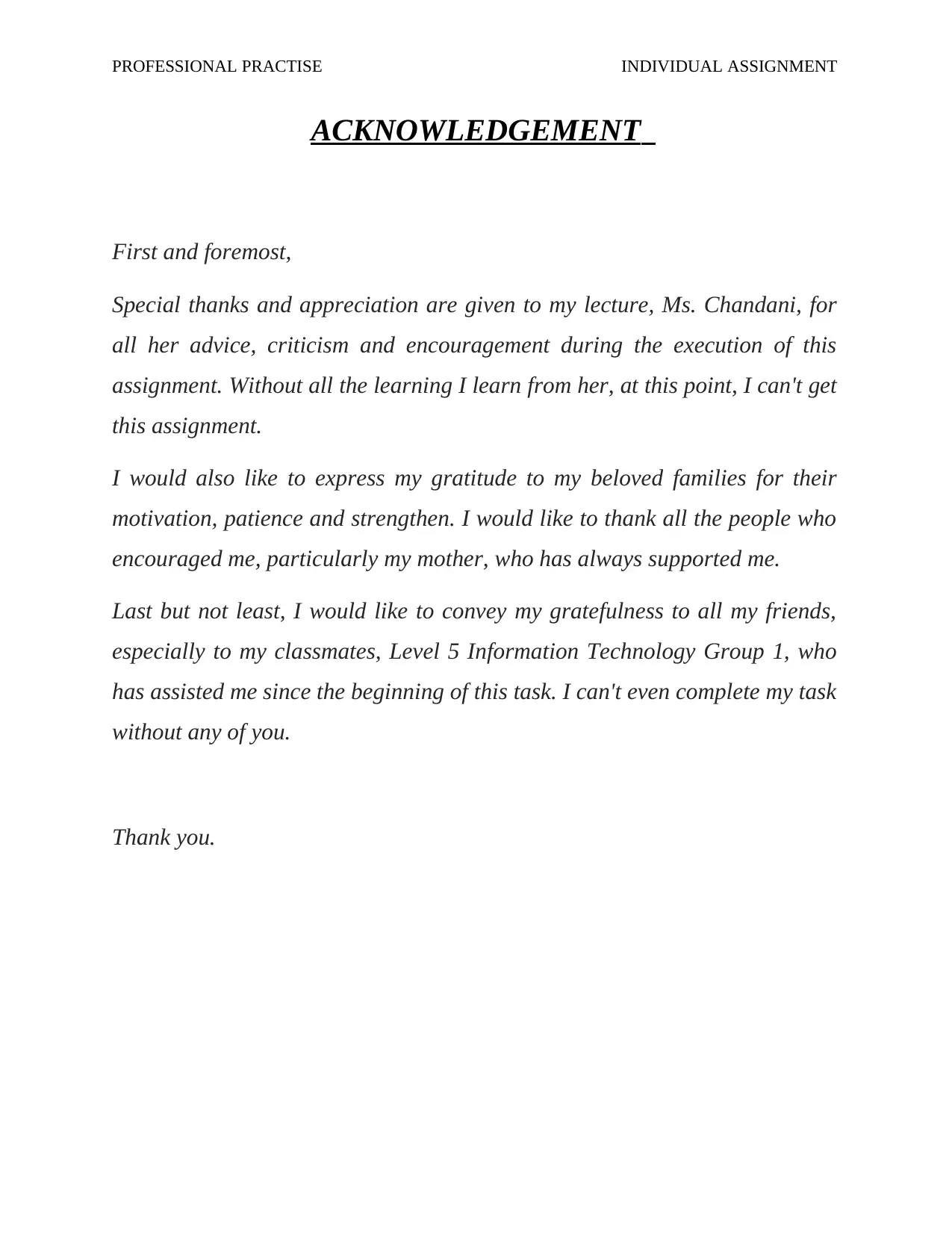
PROFESSIONAL PRACTISE INDIVIDUAL ASSIGNMENT
ACKNOWLEDGEMENT
First and foremost,
Special thanks and appreciation are given to my lecture, Ms. Chandani, for
all her advice, criticism and encouragement during the execution of this
assignment. Without all the learning I learn from her, at this point, I can't get
this assignment.
I would also like to express my gratitude to my beloved families for their
motivation, patience and strengthen. I would like to thank all the people who
encouraged me, particularly my mother, who has always supported me.
Last but not least, I would like to convey my gratefulness to all my friends,
especially to my classmates, Level 5 Information Technology Group 1, who
has assisted me since the beginning of this task. I can't even complete my task
without any of you.
Thank you.
ACKNOWLEDGEMENT
First and foremost,
Special thanks and appreciation are given to my lecture, Ms. Chandani, for
all her advice, criticism and encouragement during the execution of this
assignment. Without all the learning I learn from her, at this point, I can't get
this assignment.
I would also like to express my gratitude to my beloved families for their
motivation, patience and strengthen. I would like to thank all the people who
encouraged me, particularly my mother, who has always supported me.
Last but not least, I would like to convey my gratefulness to all my friends,
especially to my classmates, Level 5 Information Technology Group 1, who
has assisted me since the beginning of this task. I can't even complete my task
without any of you.
Thank you.
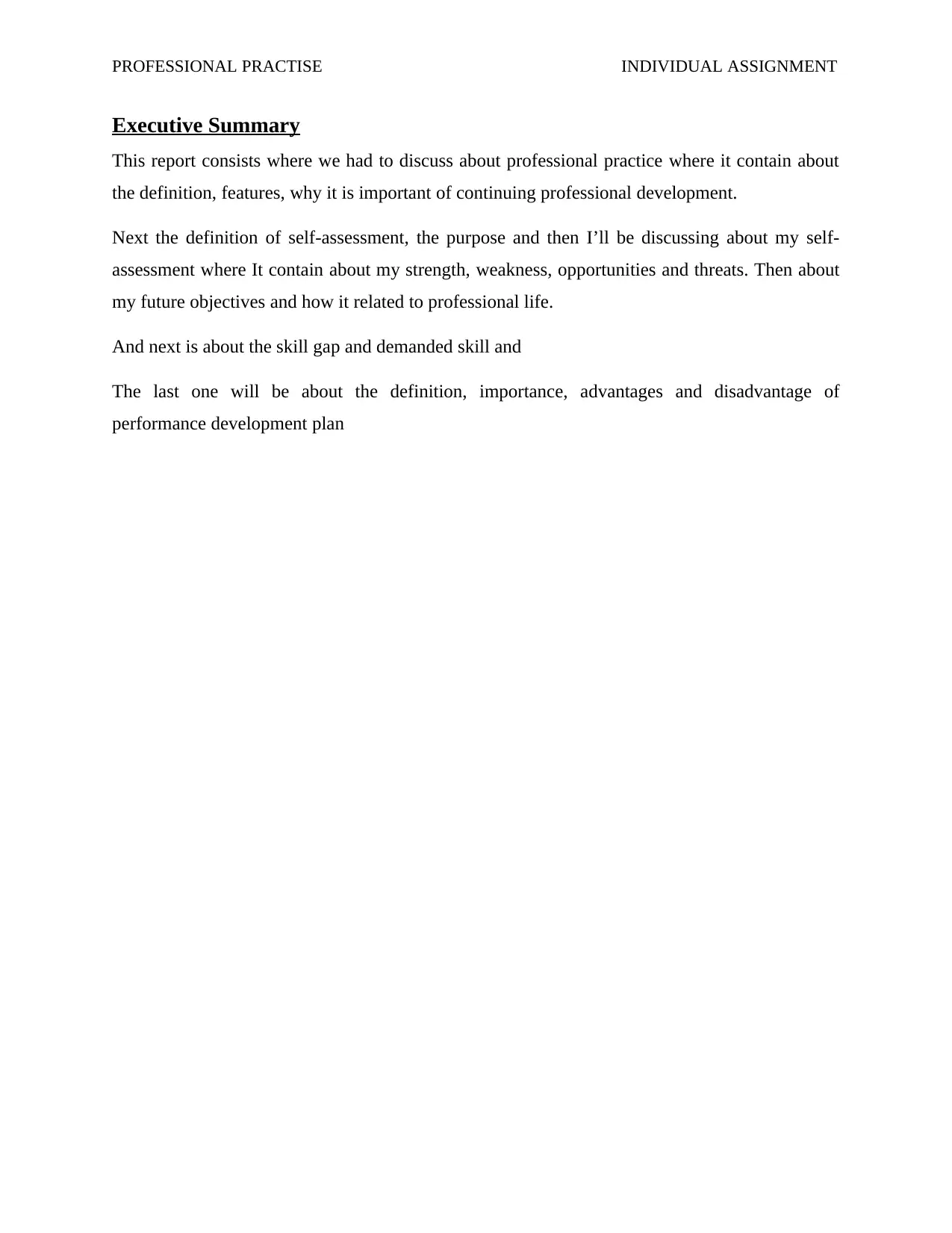
PROFESSIONAL PRACTISE INDIVIDUAL ASSIGNMENT
Executive Summary
This report consists where we had to discuss about professional practice where it contain about
the definition, features, why it is important of continuing professional development.
Next the definition of self-assessment, the purpose and then I’ll be discussing about my self-
assessment where It contain about my strength, weakness, opportunities and threats. Then about
my future objectives and how it related to professional life.
And next is about the skill gap and demanded skill and
The last one will be about the definition, importance, advantages and disadvantage of
performance development plan
Executive Summary
This report consists where we had to discuss about professional practice where it contain about
the definition, features, why it is important of continuing professional development.
Next the definition of self-assessment, the purpose and then I’ll be discussing about my self-
assessment where It contain about my strength, weakness, opportunities and threats. Then about
my future objectives and how it related to professional life.
And next is about the skill gap and demanded skill and
The last one will be about the definition, importance, advantages and disadvantage of
performance development plan
Secure Best Marks with AI Grader
Need help grading? Try our AI Grader for instant feedback on your assignments.
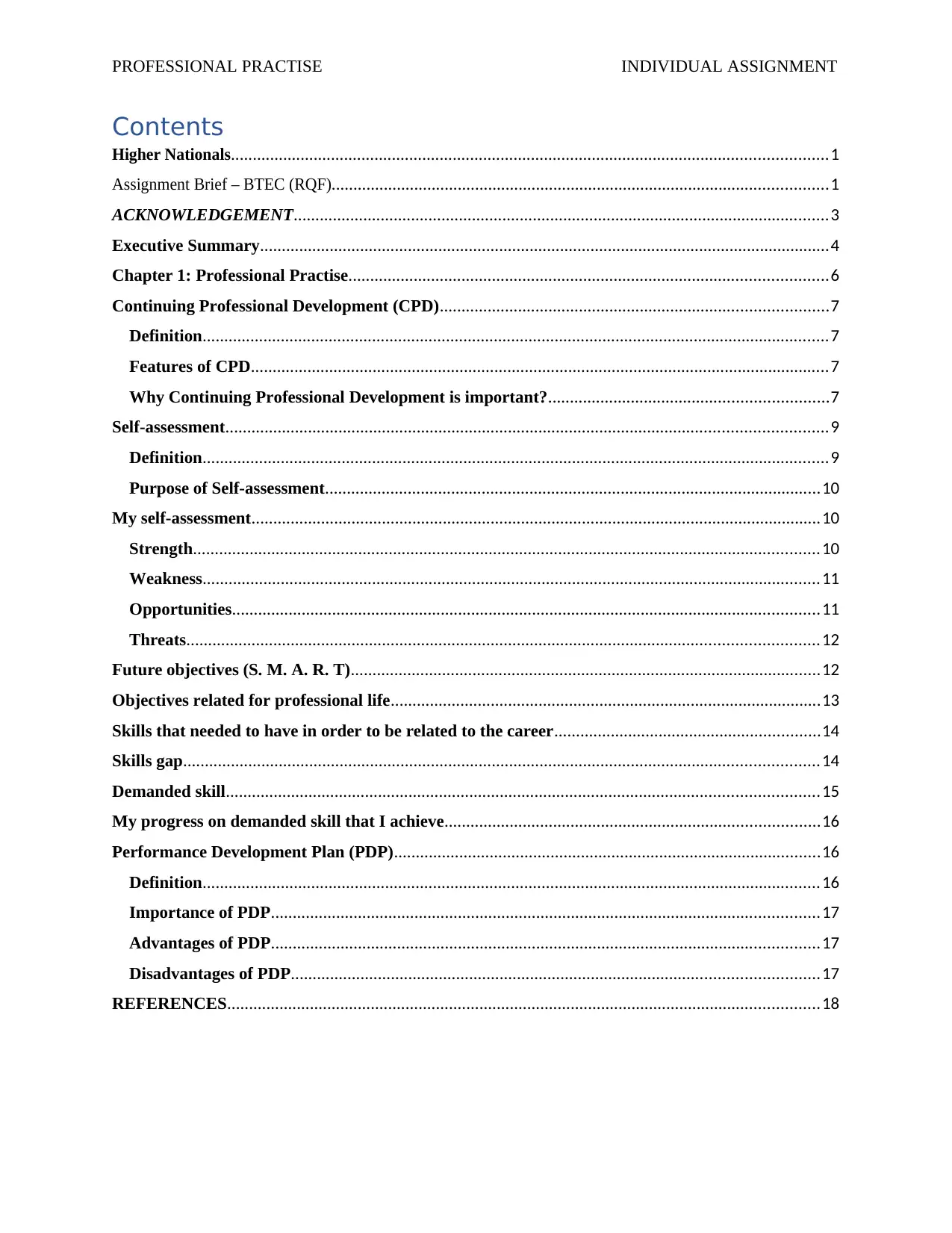
PROFESSIONAL PRACTISE INDIVIDUAL ASSIGNMENT
Contents
Higher Nationals.........................................................................................................................................1
Assignment Brief – BTEC (RQF)..................................................................................................................1
ACKNOWLEDGEMENT...........................................................................................................................3
Executive Summary...................................................................................................................................4
Chapter 1: Professional Practise..............................................................................................................6
Continuing Professional Development (CPD).........................................................................................7
Definition................................................................................................................................................7
Features of CPD.....................................................................................................................................7
Why Continuing Professional Development is important?................................................................7
Self-assessment..........................................................................................................................................9
Definition................................................................................................................................................9
Purpose of Self-assessment..................................................................................................................10
My self-assessment...................................................................................................................................10
Strength................................................................................................................................................10
Weakness..............................................................................................................................................11
Opportunities.......................................................................................................................................11
Threats.................................................................................................................................................12
Future objectives (S. M. A. R. T)............................................................................................................12
Objectives related for professional life...................................................................................................13
Skills that needed to have in order to be related to the career.............................................................14
Skills gap..................................................................................................................................................14
Demanded skill........................................................................................................................................15
My progress on demanded skill that I achieve......................................................................................16
Performance Development Plan (PDP)..................................................................................................16
Definition..............................................................................................................................................16
Importance of PDP..............................................................................................................................17
Advantages of PDP..............................................................................................................................17
Disadvantages of PDP.........................................................................................................................17
REFERENCES........................................................................................................................................18
Contents
Higher Nationals.........................................................................................................................................1
Assignment Brief – BTEC (RQF)..................................................................................................................1
ACKNOWLEDGEMENT...........................................................................................................................3
Executive Summary...................................................................................................................................4
Chapter 1: Professional Practise..............................................................................................................6
Continuing Professional Development (CPD).........................................................................................7
Definition................................................................................................................................................7
Features of CPD.....................................................................................................................................7
Why Continuing Professional Development is important?................................................................7
Self-assessment..........................................................................................................................................9
Definition................................................................................................................................................9
Purpose of Self-assessment..................................................................................................................10
My self-assessment...................................................................................................................................10
Strength................................................................................................................................................10
Weakness..............................................................................................................................................11
Opportunities.......................................................................................................................................11
Threats.................................................................................................................................................12
Future objectives (S. M. A. R. T)............................................................................................................12
Objectives related for professional life...................................................................................................13
Skills that needed to have in order to be related to the career.............................................................14
Skills gap..................................................................................................................................................14
Demanded skill........................................................................................................................................15
My progress on demanded skill that I achieve......................................................................................16
Performance Development Plan (PDP)..................................................................................................16
Definition..............................................................................................................................................16
Importance of PDP..............................................................................................................................17
Advantages of PDP..............................................................................................................................17
Disadvantages of PDP.........................................................................................................................17
REFERENCES........................................................................................................................................18
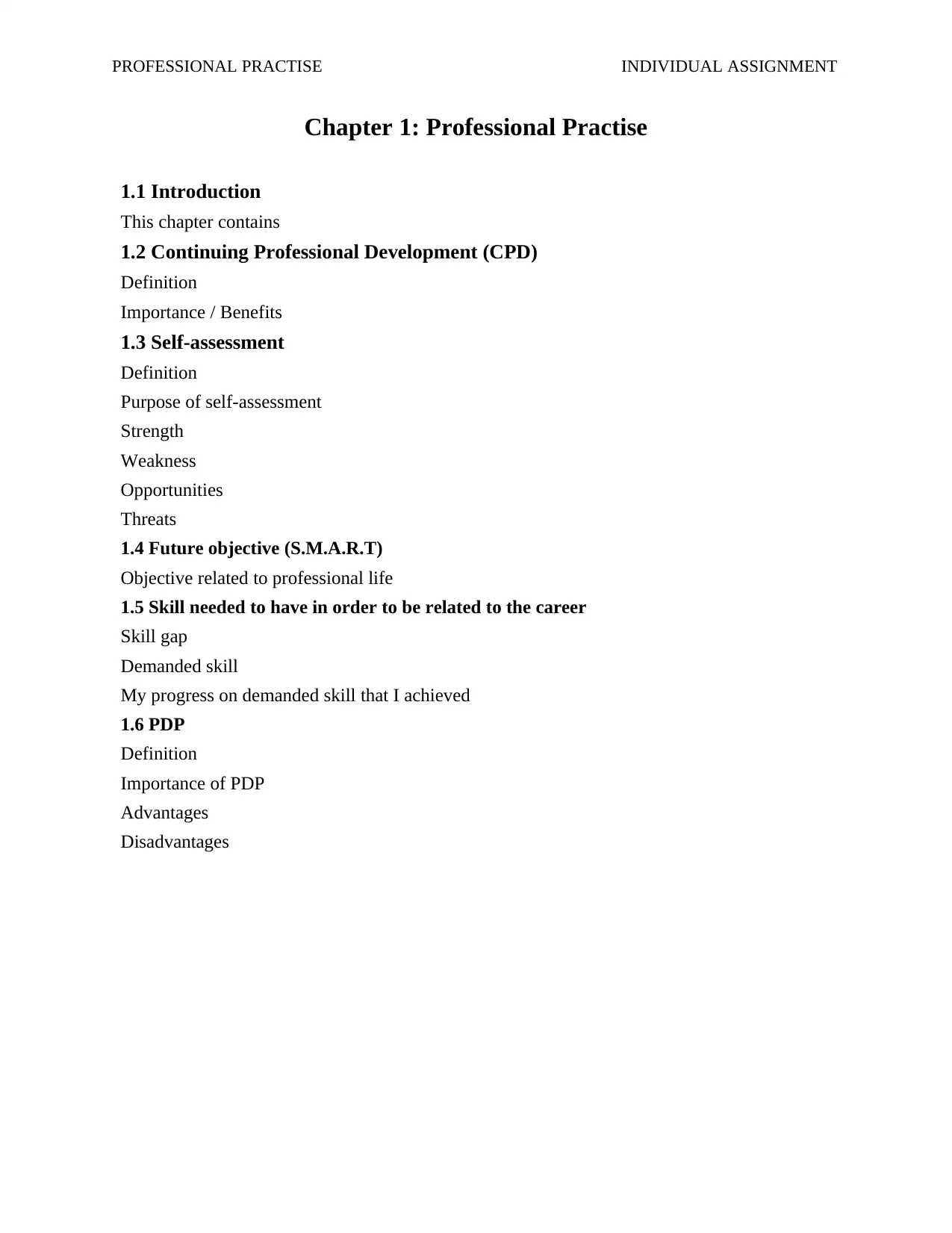
PROFESSIONAL PRACTISE INDIVIDUAL ASSIGNMENT
Chapter 1: Professional Practise
1.1 Introduction
This chapter contains
1.2 Continuing Professional Development (CPD)
Definition
Importance / Benefits
1.3 Self-assessment
Definition
Purpose of self-assessment
Strength
Weakness
Opportunities
Threats
1.4 Future objective (S.M.A.R.T)
Objective related to professional life
1.5 Skill needed to have in order to be related to the career
Skill gap
Demanded skill
My progress on demanded skill that I achieved
1.6 PDP
Definition
Importance of PDP
Advantages
Disadvantages
Chapter 1: Professional Practise
1.1 Introduction
This chapter contains
1.2 Continuing Professional Development (CPD)
Definition
Importance / Benefits
1.3 Self-assessment
Definition
Purpose of self-assessment
Strength
Weakness
Opportunities
Threats
1.4 Future objective (S.M.A.R.T)
Objective related to professional life
1.5 Skill needed to have in order to be related to the career
Skill gap
Demanded skill
My progress on demanded skill that I achieved
1.6 PDP
Definition
Importance of PDP
Advantages
Disadvantages
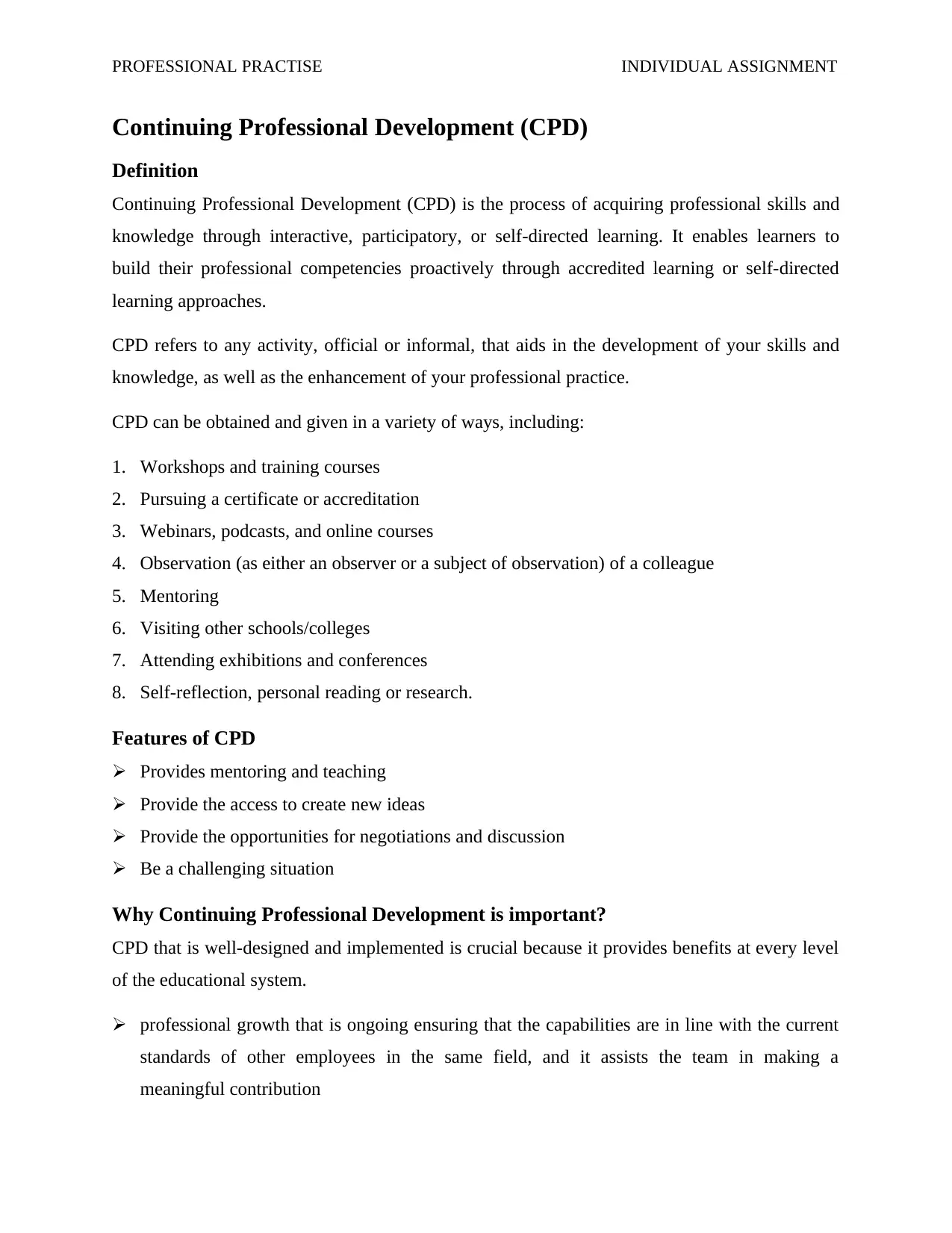
PROFESSIONAL PRACTISE INDIVIDUAL ASSIGNMENT
Continuing Professional Development (CPD)
Definition
Continuing Professional Development (CPD) is the process of acquiring professional skills and
knowledge through interactive, participatory, or self-directed learning. It enables learners to
build their professional competencies proactively through accredited learning or self-directed
learning approaches.
CPD refers to any activity, official or informal, that aids in the development of your skills and
knowledge, as well as the enhancement of your professional practice.
CPD can be obtained and given in a variety of ways, including:
1. Workshops and training courses
2. Pursuing a certificate or accreditation
3. Webinars, podcasts, and online courses
4. Observation (as either an observer or a subject of observation) of a colleague
5. Mentoring
6. Visiting other schools/colleges
7. Attending exhibitions and conferences
8. Self-reflection, personal reading or research.
Features of CPD
Provides mentoring and teaching
Provide the access to create new ideas
Provide the opportunities for negotiations and discussion
Be a challenging situation
Why Continuing Professional Development is important?
CPD that is well-designed and implemented is crucial because it provides benefits at every level
of the educational system.
professional growth that is ongoing ensuring that the capabilities are in line with the current
standards of other employees in the same field, and it assists the team in making a
meaningful contribution
Continuing Professional Development (CPD)
Definition
Continuing Professional Development (CPD) is the process of acquiring professional skills and
knowledge through interactive, participatory, or self-directed learning. It enables learners to
build their professional competencies proactively through accredited learning or self-directed
learning approaches.
CPD refers to any activity, official or informal, that aids in the development of your skills and
knowledge, as well as the enhancement of your professional practice.
CPD can be obtained and given in a variety of ways, including:
1. Workshops and training courses
2. Pursuing a certificate or accreditation
3. Webinars, podcasts, and online courses
4. Observation (as either an observer or a subject of observation) of a colleague
5. Mentoring
6. Visiting other schools/colleges
7. Attending exhibitions and conferences
8. Self-reflection, personal reading or research.
Features of CPD
Provides mentoring and teaching
Provide the access to create new ideas
Provide the opportunities for negotiations and discussion
Be a challenging situation
Why Continuing Professional Development is important?
CPD that is well-designed and implemented is crucial because it provides benefits at every level
of the educational system.
professional growth that is ongoing ensuring that the capabilities are in line with the current
standards of other employees in the same field, and it assists the team in making a
meaningful contribution
Paraphrase This Document
Need a fresh take? Get an instant paraphrase of this document with our AI Paraphraser
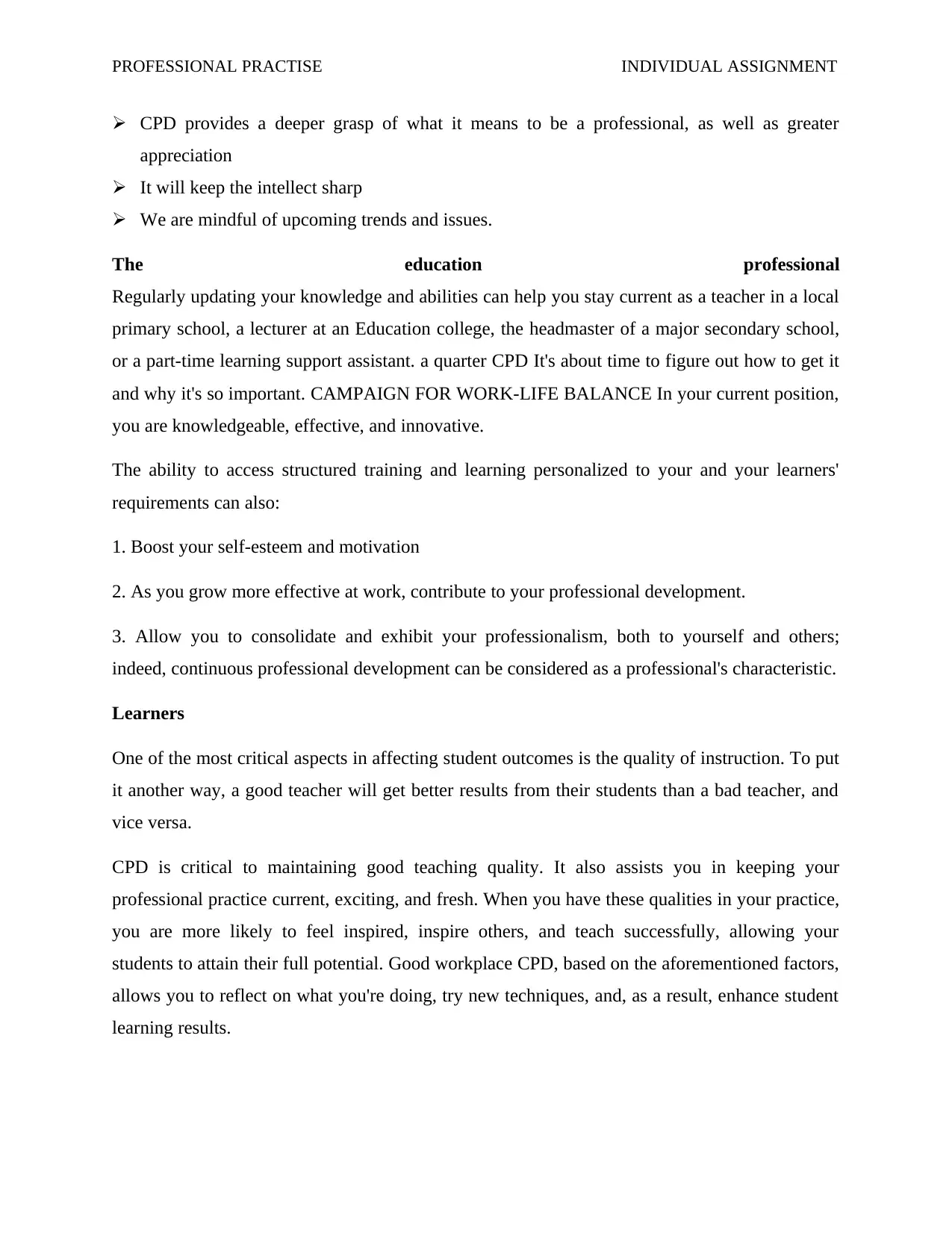
PROFESSIONAL PRACTISE INDIVIDUAL ASSIGNMENT
CPD provides a deeper grasp of what it means to be a professional, as well as greater
appreciation
It will keep the intellect sharp
We are mindful of upcoming trends and issues.
The education professional
Regularly updating your knowledge and abilities can help you stay current as a teacher in a local
primary school, a lecturer at an Education college, the headmaster of a major secondary school,
or a part-time learning support assistant. a quarter CPD It's about time to figure out how to get it
and why it's so important. CAMPAIGN FOR WORK-LIFE BALANCE In your current position,
you are knowledgeable, effective, and innovative.
The ability to access structured training and learning personalized to your and your learners'
requirements can also:
1. Boost your self-esteem and motivation
2. As you grow more effective at work, contribute to your professional development.
3. Allow you to consolidate and exhibit your professionalism, both to yourself and others;
indeed, continuous professional development can be considered as a professional's characteristic.
Learners
One of the most critical aspects in affecting student outcomes is the quality of instruction. To put
it another way, a good teacher will get better results from their students than a bad teacher, and
vice versa.
CPD is critical to maintaining good teaching quality. It also assists you in keeping your
professional practice current, exciting, and fresh. When you have these qualities in your practice,
you are more likely to feel inspired, inspire others, and teach successfully, allowing your
students to attain their full potential. Good workplace CPD, based on the aforementioned factors,
allows you to reflect on what you're doing, try new techniques, and, as a result, enhance student
learning results.
CPD provides a deeper grasp of what it means to be a professional, as well as greater
appreciation
It will keep the intellect sharp
We are mindful of upcoming trends and issues.
The education professional
Regularly updating your knowledge and abilities can help you stay current as a teacher in a local
primary school, a lecturer at an Education college, the headmaster of a major secondary school,
or a part-time learning support assistant. a quarter CPD It's about time to figure out how to get it
and why it's so important. CAMPAIGN FOR WORK-LIFE BALANCE In your current position,
you are knowledgeable, effective, and innovative.
The ability to access structured training and learning personalized to your and your learners'
requirements can also:
1. Boost your self-esteem and motivation
2. As you grow more effective at work, contribute to your professional development.
3. Allow you to consolidate and exhibit your professionalism, both to yourself and others;
indeed, continuous professional development can be considered as a professional's characteristic.
Learners
One of the most critical aspects in affecting student outcomes is the quality of instruction. To put
it another way, a good teacher will get better results from their students than a bad teacher, and
vice versa.
CPD is critical to maintaining good teaching quality. It also assists you in keeping your
professional practice current, exciting, and fresh. When you have these qualities in your practice,
you are more likely to feel inspired, inspire others, and teach successfully, allowing your
students to attain their full potential. Good workplace CPD, based on the aforementioned factors,
allows you to reflect on what you're doing, try new techniques, and, as a result, enhance student
learning results.
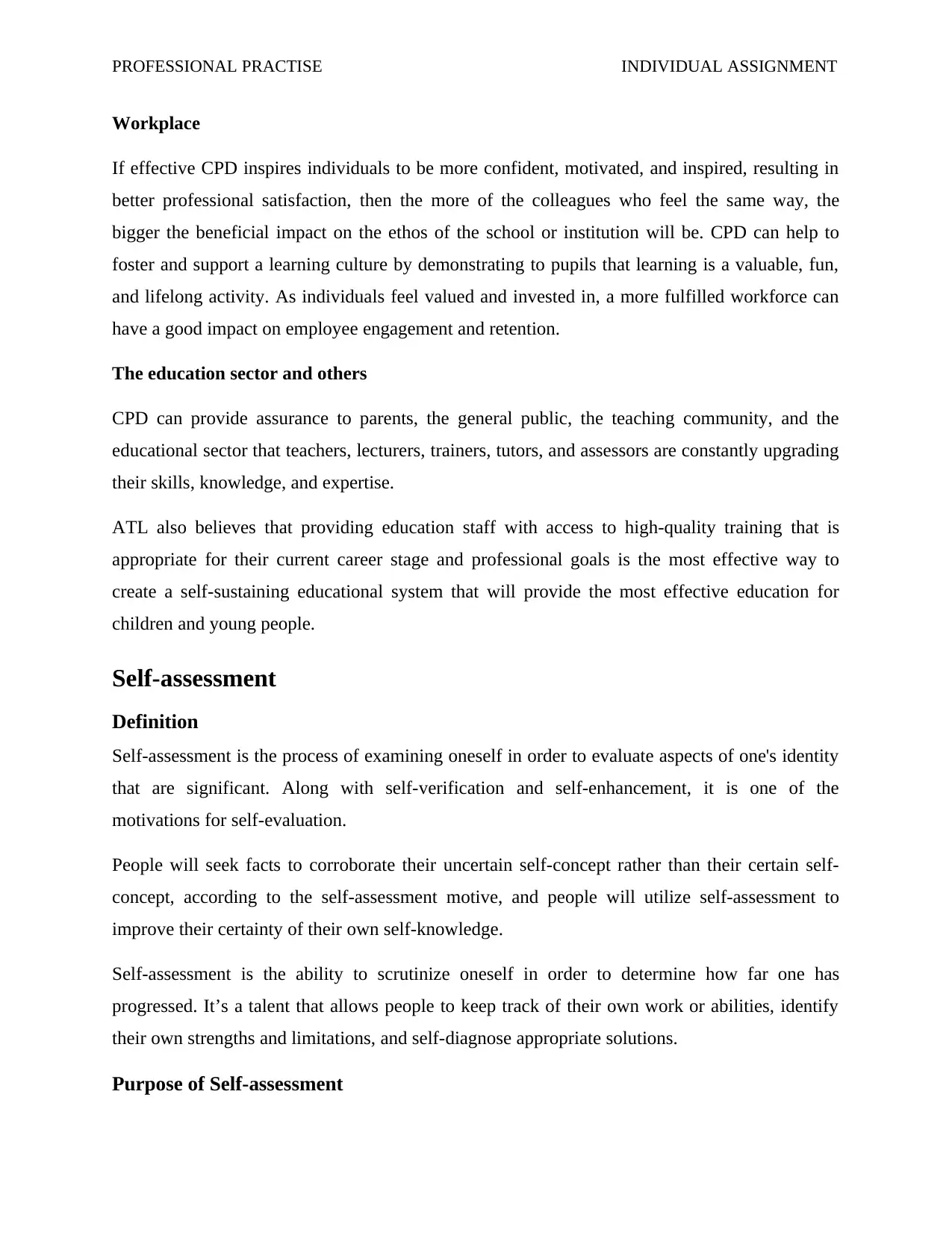
PROFESSIONAL PRACTISE INDIVIDUAL ASSIGNMENT
Workplace
If effective CPD inspires individuals to be more confident, motivated, and inspired, resulting in
better professional satisfaction, then the more of the colleagues who feel the same way, the
bigger the beneficial impact on the ethos of the school or institution will be. CPD can help to
foster and support a learning culture by demonstrating to pupils that learning is a valuable, fun,
and lifelong activity. As individuals feel valued and invested in, a more fulfilled workforce can
have a good impact on employee engagement and retention.
The education sector and others
CPD can provide assurance to parents, the general public, the teaching community, and the
educational sector that teachers, lecturers, trainers, tutors, and assessors are constantly upgrading
their skills, knowledge, and expertise.
ATL also believes that providing education staff with access to high-quality training that is
appropriate for their current career stage and professional goals is the most effective way to
create a self-sustaining educational system that will provide the most effective education for
children and young people.
Self-assessment
Definition
Self-assessment is the process of examining oneself in order to evaluate aspects of one's identity
that are significant. Along with self-verification and self-enhancement, it is one of the
motivations for self-evaluation.
People will seek facts to corroborate their uncertain self-concept rather than their certain self-
concept, according to the self-assessment motive, and people will utilize self-assessment to
improve their certainty of their own self-knowledge.
Self-assessment is the ability to scrutinize oneself in order to determine how far one has
progressed. It’s a talent that allows people to keep track of their own work or abilities, identify
their own strengths and limitations, and self-diagnose appropriate solutions.
Purpose of Self-assessment
Workplace
If effective CPD inspires individuals to be more confident, motivated, and inspired, resulting in
better professional satisfaction, then the more of the colleagues who feel the same way, the
bigger the beneficial impact on the ethos of the school or institution will be. CPD can help to
foster and support a learning culture by demonstrating to pupils that learning is a valuable, fun,
and lifelong activity. As individuals feel valued and invested in, a more fulfilled workforce can
have a good impact on employee engagement and retention.
The education sector and others
CPD can provide assurance to parents, the general public, the teaching community, and the
educational sector that teachers, lecturers, trainers, tutors, and assessors are constantly upgrading
their skills, knowledge, and expertise.
ATL also believes that providing education staff with access to high-quality training that is
appropriate for their current career stage and professional goals is the most effective way to
create a self-sustaining educational system that will provide the most effective education for
children and young people.
Self-assessment
Definition
Self-assessment is the process of examining oneself in order to evaluate aspects of one's identity
that are significant. Along with self-verification and self-enhancement, it is one of the
motivations for self-evaluation.
People will seek facts to corroborate their uncertain self-concept rather than their certain self-
concept, according to the self-assessment motive, and people will utilize self-assessment to
improve their certainty of their own self-knowledge.
Self-assessment is the ability to scrutinize oneself in order to determine how far one has
progressed. It’s a talent that allows people to keep track of their own work or abilities, identify
their own strengths and limitations, and self-diagnose appropriate solutions.
Purpose of Self-assessment
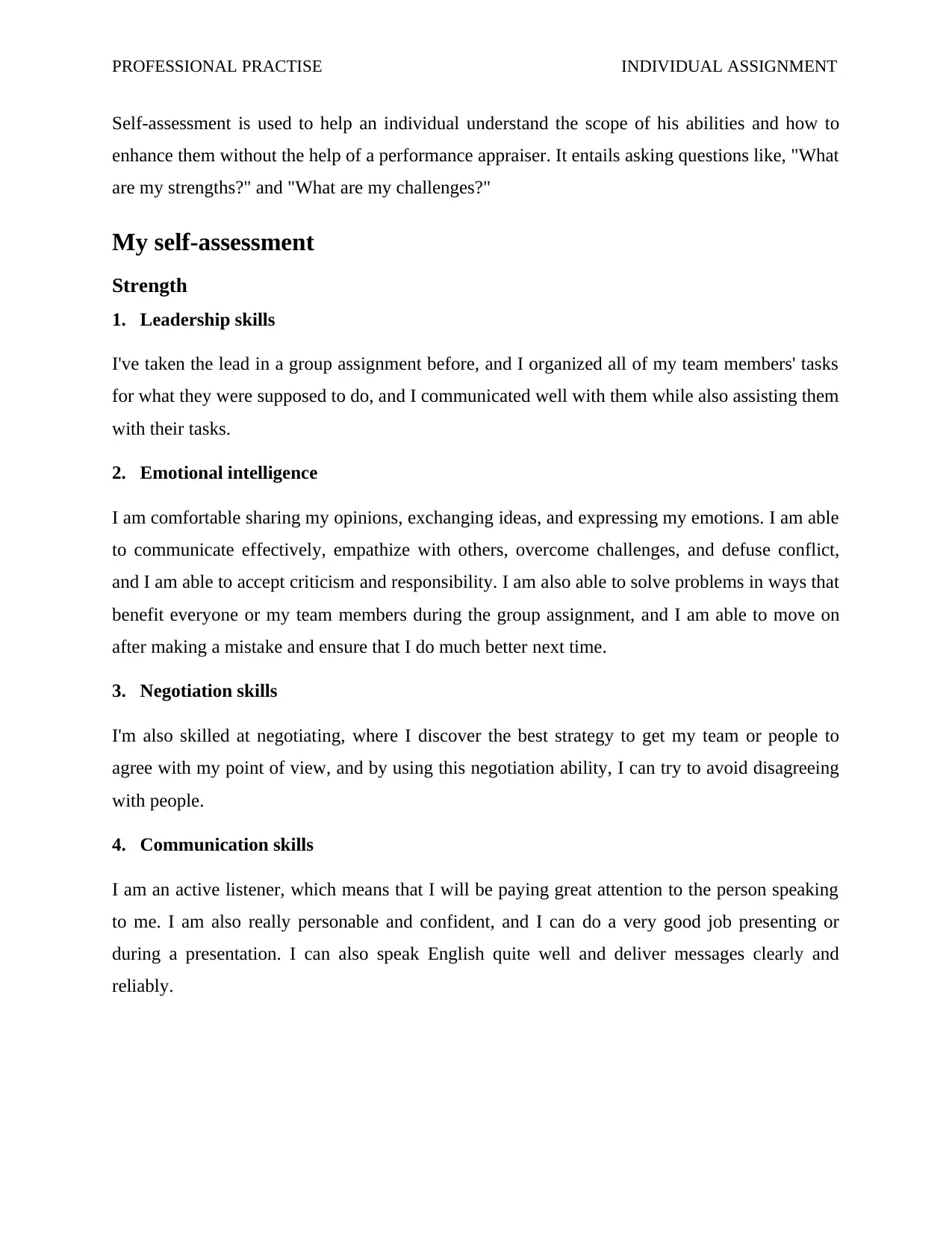
PROFESSIONAL PRACTISE INDIVIDUAL ASSIGNMENT
Self-assessment is used to help an individual understand the scope of his abilities and how to
enhance them without the help of a performance appraiser. It entails asking questions like, "What
are my strengths?" and "What are my challenges?"
My self-assessment
Strength
1. Leadership skills
I've taken the lead in a group assignment before, and I organized all of my team members' tasks
for what they were supposed to do, and I communicated well with them while also assisting them
with their tasks.
2. Emotional intelligence
I am comfortable sharing my opinions, exchanging ideas, and expressing my emotions. I am able
to communicate effectively, empathize with others, overcome challenges, and defuse conflict,
and I am able to accept criticism and responsibility. I am also able to solve problems in ways that
benefit everyone or my team members during the group assignment, and I am able to move on
after making a mistake and ensure that I do much better next time.
3. Negotiation skills
I'm also skilled at negotiating, where I discover the best strategy to get my team or people to
agree with my point of view, and by using this negotiation ability, I can try to avoid disagreeing
with people.
4. Communication skills
I am an active listener, which means that I will be paying great attention to the person speaking
to me. I am also really personable and confident, and I can do a very good job presenting or
during a presentation. I can also speak English quite well and deliver messages clearly and
reliably.
Self-assessment is used to help an individual understand the scope of his abilities and how to
enhance them without the help of a performance appraiser. It entails asking questions like, "What
are my strengths?" and "What are my challenges?"
My self-assessment
Strength
1. Leadership skills
I've taken the lead in a group assignment before, and I organized all of my team members' tasks
for what they were supposed to do, and I communicated well with them while also assisting them
with their tasks.
2. Emotional intelligence
I am comfortable sharing my opinions, exchanging ideas, and expressing my emotions. I am able
to communicate effectively, empathize with others, overcome challenges, and defuse conflict,
and I am able to accept criticism and responsibility. I am also able to solve problems in ways that
benefit everyone or my team members during the group assignment, and I am able to move on
after making a mistake and ensure that I do much better next time.
3. Negotiation skills
I'm also skilled at negotiating, where I discover the best strategy to get my team or people to
agree with my point of view, and by using this negotiation ability, I can try to avoid disagreeing
with people.
4. Communication skills
I am an active listener, which means that I will be paying great attention to the person speaking
to me. I am also really personable and confident, and I can do a very good job presenting or
during a presentation. I can also speak English quite well and deliver messages clearly and
reliably.
Secure Best Marks with AI Grader
Need help grading? Try our AI Grader for instant feedback on your assignments.
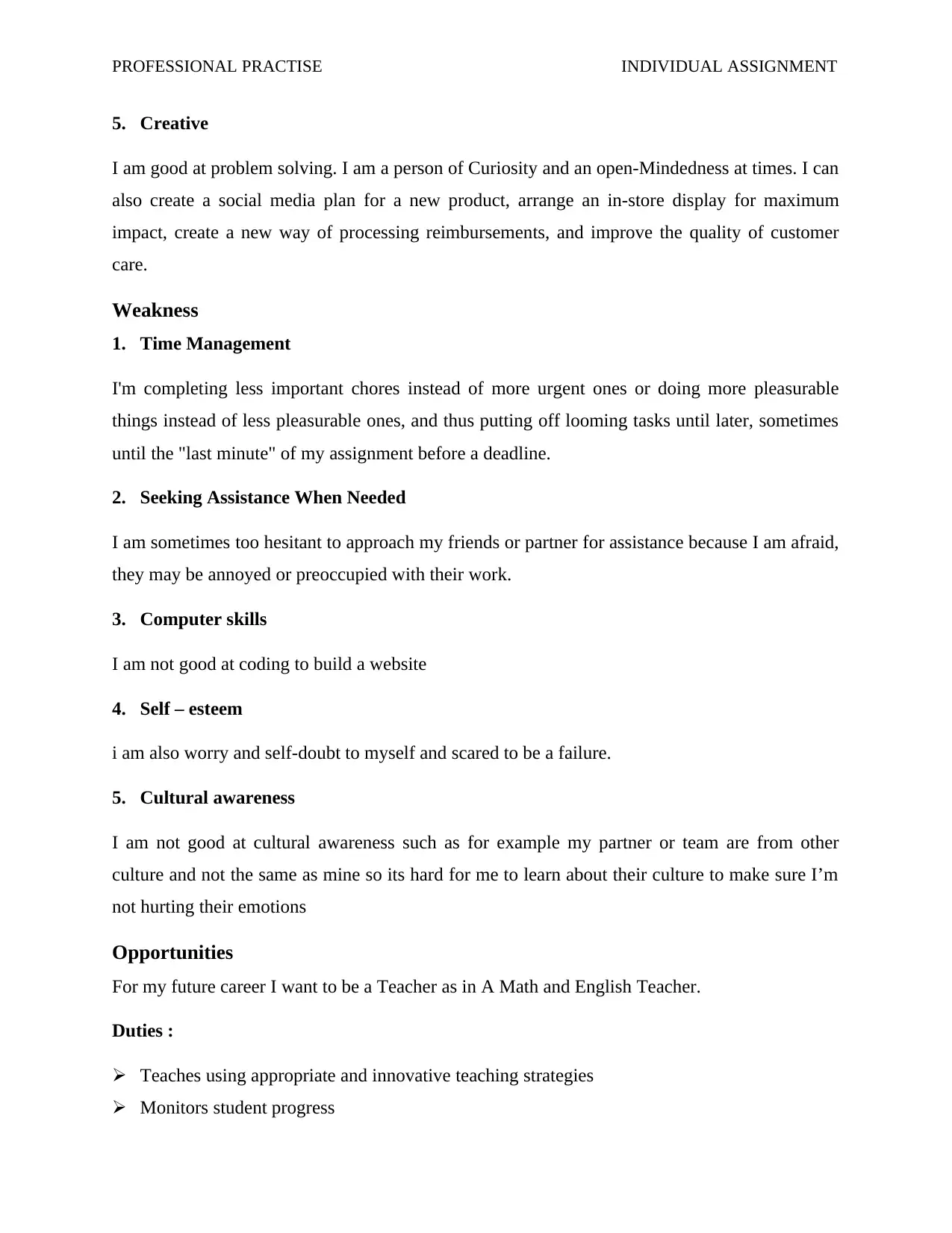
PROFESSIONAL PRACTISE INDIVIDUAL ASSIGNMENT
5. Creative
I am good at problem solving. I am a person of Curiosity and an open-Mindedness at times. I can
also create a social media plan for a new product, arrange an in-store display for maximum
impact, create a new way of processing reimbursements, and improve the quality of customer
care.
Weakness
1. Time Management
I'm completing less important chores instead of more urgent ones or doing more pleasurable
things instead of less pleasurable ones, and thus putting off looming tasks until later, sometimes
until the "last minute" of my assignment before a deadline.
2. Seeking Assistance When Needed
I am sometimes too hesitant to approach my friends or partner for assistance because I am afraid,
they may be annoyed or preoccupied with their work.
3. Computer skills
I am not good at coding to build a website
4. Self – esteem
i am also worry and self-doubt to myself and scared to be a failure.
5. Cultural awareness
I am not good at cultural awareness such as for example my partner or team are from other
culture and not the same as mine so its hard for me to learn about their culture to make sure I’m
not hurting their emotions
Opportunities
For my future career I want to be a Teacher as in A Math and English Teacher.
Duties :
Teaches using appropriate and innovative teaching strategies
Monitors student progress
5. Creative
I am good at problem solving. I am a person of Curiosity and an open-Mindedness at times. I can
also create a social media plan for a new product, arrange an in-store display for maximum
impact, create a new way of processing reimbursements, and improve the quality of customer
care.
Weakness
1. Time Management
I'm completing less important chores instead of more urgent ones or doing more pleasurable
things instead of less pleasurable ones, and thus putting off looming tasks until later, sometimes
until the "last minute" of my assignment before a deadline.
2. Seeking Assistance When Needed
I am sometimes too hesitant to approach my friends or partner for assistance because I am afraid,
they may be annoyed or preoccupied with their work.
3. Computer skills
I am not good at coding to build a website
4. Self – esteem
i am also worry and self-doubt to myself and scared to be a failure.
5. Cultural awareness
I am not good at cultural awareness such as for example my partner or team are from other
culture and not the same as mine so its hard for me to learn about their culture to make sure I’m
not hurting their emotions
Opportunities
For my future career I want to be a Teacher as in A Math and English Teacher.
Duties :
Teaches using appropriate and innovative teaching strategies
Monitors student progress
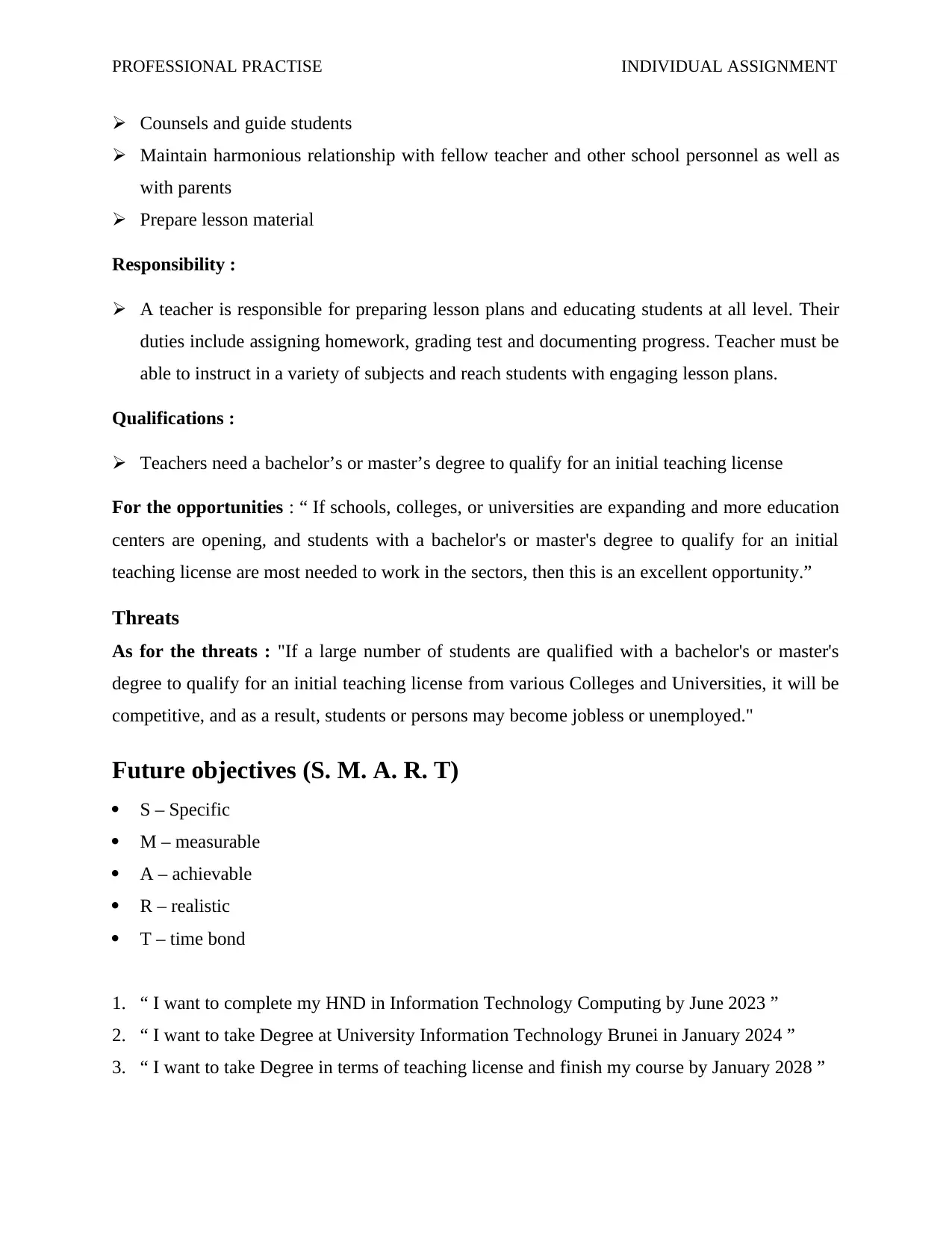
PROFESSIONAL PRACTISE INDIVIDUAL ASSIGNMENT
Counsels and guide students
Maintain harmonious relationship with fellow teacher and other school personnel as well as
with parents
Prepare lesson material
Responsibility :
A teacher is responsible for preparing lesson plans and educating students at all level. Their
duties include assigning homework, grading test and documenting progress. Teacher must be
able to instruct in a variety of subjects and reach students with engaging lesson plans.
Qualifications :
Teachers need a bachelor’s or master’s degree to qualify for an initial teaching license
For the opportunities : “ If schools, colleges, or universities are expanding and more education
centers are opening, and students with a bachelor's or master's degree to qualify for an initial
teaching license are most needed to work in the sectors, then this is an excellent opportunity.”
Threats
As for the threats : "If a large number of students are qualified with a bachelor's or master's
degree to qualify for an initial teaching license from various Colleges and Universities, it will be
competitive, and as a result, students or persons may become jobless or unemployed."
Future objectives (S. M. A. R. T)
S – Specific
M – measurable
A – achievable
R – realistic
T – time bond
1. “ I want to complete my HND in Information Technology Computing by June 2023 ”
2. “ I want to take Degree at University Information Technology Brunei in January 2024 ”
3. “ I want to take Degree in terms of teaching license and finish my course by January 2028 ”
Counsels and guide students
Maintain harmonious relationship with fellow teacher and other school personnel as well as
with parents
Prepare lesson material
Responsibility :
A teacher is responsible for preparing lesson plans and educating students at all level. Their
duties include assigning homework, grading test and documenting progress. Teacher must be
able to instruct in a variety of subjects and reach students with engaging lesson plans.
Qualifications :
Teachers need a bachelor’s or master’s degree to qualify for an initial teaching license
For the opportunities : “ If schools, colleges, or universities are expanding and more education
centers are opening, and students with a bachelor's or master's degree to qualify for an initial
teaching license are most needed to work in the sectors, then this is an excellent opportunity.”
Threats
As for the threats : "If a large number of students are qualified with a bachelor's or master's
degree to qualify for an initial teaching license from various Colleges and Universities, it will be
competitive, and as a result, students or persons may become jobless or unemployed."
Future objectives (S. M. A. R. T)
S – Specific
M – measurable
A – achievable
R – realistic
T – time bond
1. “ I want to complete my HND in Information Technology Computing by June 2023 ”
2. “ I want to take Degree at University Information Technology Brunei in January 2024 ”
3. “ I want to take Degree in terms of teaching license and finish my course by January 2028 ”
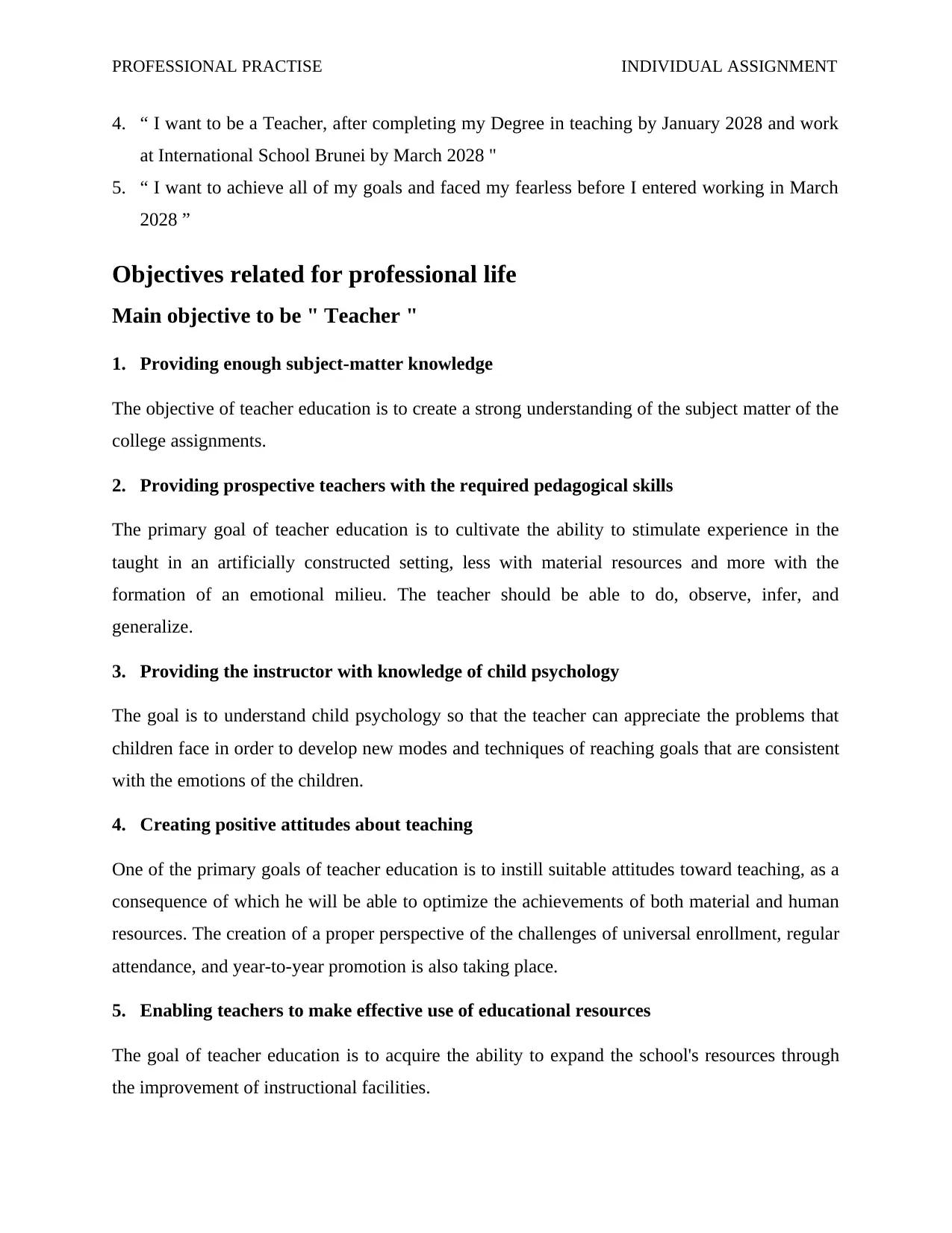
PROFESSIONAL PRACTISE INDIVIDUAL ASSIGNMENT
4. “ I want to be a Teacher, after completing my Degree in teaching by January 2028 and work
at International School Brunei by March 2028 "
5. “ I want to achieve all of my goals and faced my fearless before I entered working in March
2028 ”
Objectives related for professional life
Main objective to be " Teacher "
1. Providing enough subject-matter knowledge
The objective of teacher education is to create a strong understanding of the subject matter of the
college assignments.
2. Providing prospective teachers with the required pedagogical skills
The primary goal of teacher education is to cultivate the ability to stimulate experience in the
taught in an artificially constructed setting, less with material resources and more with the
formation of an emotional milieu. The teacher should be able to do, observe, infer, and
generalize.
3. Providing the instructor with knowledge of child psychology
The goal is to understand child psychology so that the teacher can appreciate the problems that
children face in order to develop new modes and techniques of reaching goals that are consistent
with the emotions of the children.
4. Creating positive attitudes about teaching
One of the primary goals of teacher education is to instill suitable attitudes toward teaching, as a
consequence of which he will be able to optimize the achievements of both material and human
resources. The creation of a proper perspective of the challenges of universal enrollment, regular
attendance, and year-to-year promotion is also taking place.
5. Enabling teachers to make effective use of educational resources
The goal of teacher education is to acquire the ability to expand the school's resources through
the improvement of instructional facilities.
4. “ I want to be a Teacher, after completing my Degree in teaching by January 2028 and work
at International School Brunei by March 2028 "
5. “ I want to achieve all of my goals and faced my fearless before I entered working in March
2028 ”
Objectives related for professional life
Main objective to be " Teacher "
1. Providing enough subject-matter knowledge
The objective of teacher education is to create a strong understanding of the subject matter of the
college assignments.
2. Providing prospective teachers with the required pedagogical skills
The primary goal of teacher education is to cultivate the ability to stimulate experience in the
taught in an artificially constructed setting, less with material resources and more with the
formation of an emotional milieu. The teacher should be able to do, observe, infer, and
generalize.
3. Providing the instructor with knowledge of child psychology
The goal is to understand child psychology so that the teacher can appreciate the problems that
children face in order to develop new modes and techniques of reaching goals that are consistent
with the emotions of the children.
4. Creating positive attitudes about teaching
One of the primary goals of teacher education is to instill suitable attitudes toward teaching, as a
consequence of which he will be able to optimize the achievements of both material and human
resources. The creation of a proper perspective of the challenges of universal enrollment, regular
attendance, and year-to-year promotion is also taking place.
5. Enabling teachers to make effective use of educational resources
The goal of teacher education is to acquire the ability to expand the school's resources through
the improvement of instructional facilities.
Paraphrase This Document
Need a fresh take? Get an instant paraphrase of this document with our AI Paraphraser
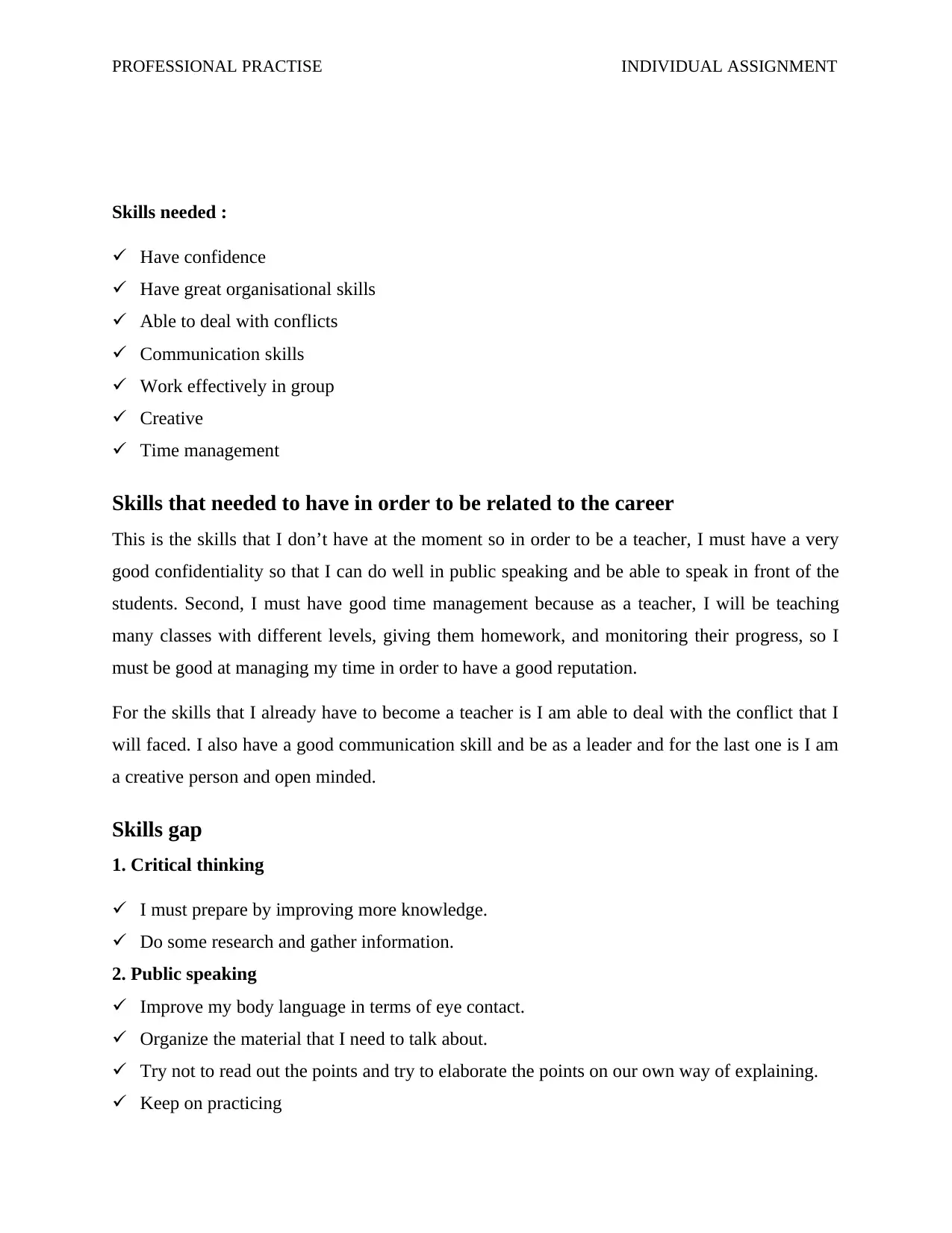
PROFESSIONAL PRACTISE INDIVIDUAL ASSIGNMENT
Skills needed :
Have confidence
Have great organisational skills
Able to deal with conflicts
Communication skills
Work effectively in group
Creative
Time management
Skills that needed to have in order to be related to the career
This is the skills that I don’t have at the moment so in order to be a teacher, I must have a very
good confidentiality so that I can do well in public speaking and be able to speak in front of the
students. Second, I must have good time management because as a teacher, I will be teaching
many classes with different levels, giving them homework, and monitoring their progress, so I
must be good at managing my time in order to have a good reputation.
For the skills that I already have to become a teacher is I am able to deal with the conflict that I
will faced. I also have a good communication skill and be as a leader and for the last one is I am
a creative person and open minded.
Skills gap
1. Critical thinking
I must prepare by improving more knowledge.
Do some research and gather information.
2. Public speaking
Improve my body language in terms of eye contact.
Organize the material that I need to talk about.
Try not to read out the points and try to elaborate the points on our own way of explaining.
Keep on practicing
Skills needed :
Have confidence
Have great organisational skills
Able to deal with conflicts
Communication skills
Work effectively in group
Creative
Time management
Skills that needed to have in order to be related to the career
This is the skills that I don’t have at the moment so in order to be a teacher, I must have a very
good confidentiality so that I can do well in public speaking and be able to speak in front of the
students. Second, I must have good time management because as a teacher, I will be teaching
many classes with different levels, giving them homework, and monitoring their progress, so I
must be good at managing my time in order to have a good reputation.
For the skills that I already have to become a teacher is I am able to deal with the conflict that I
will faced. I also have a good communication skill and be as a leader and for the last one is I am
a creative person and open minded.
Skills gap
1. Critical thinking
I must prepare by improving more knowledge.
Do some research and gather information.
2. Public speaking
Improve my body language in terms of eye contact.
Organize the material that I need to talk about.
Try not to read out the points and try to elaborate the points on our own way of explaining.
Keep on practicing
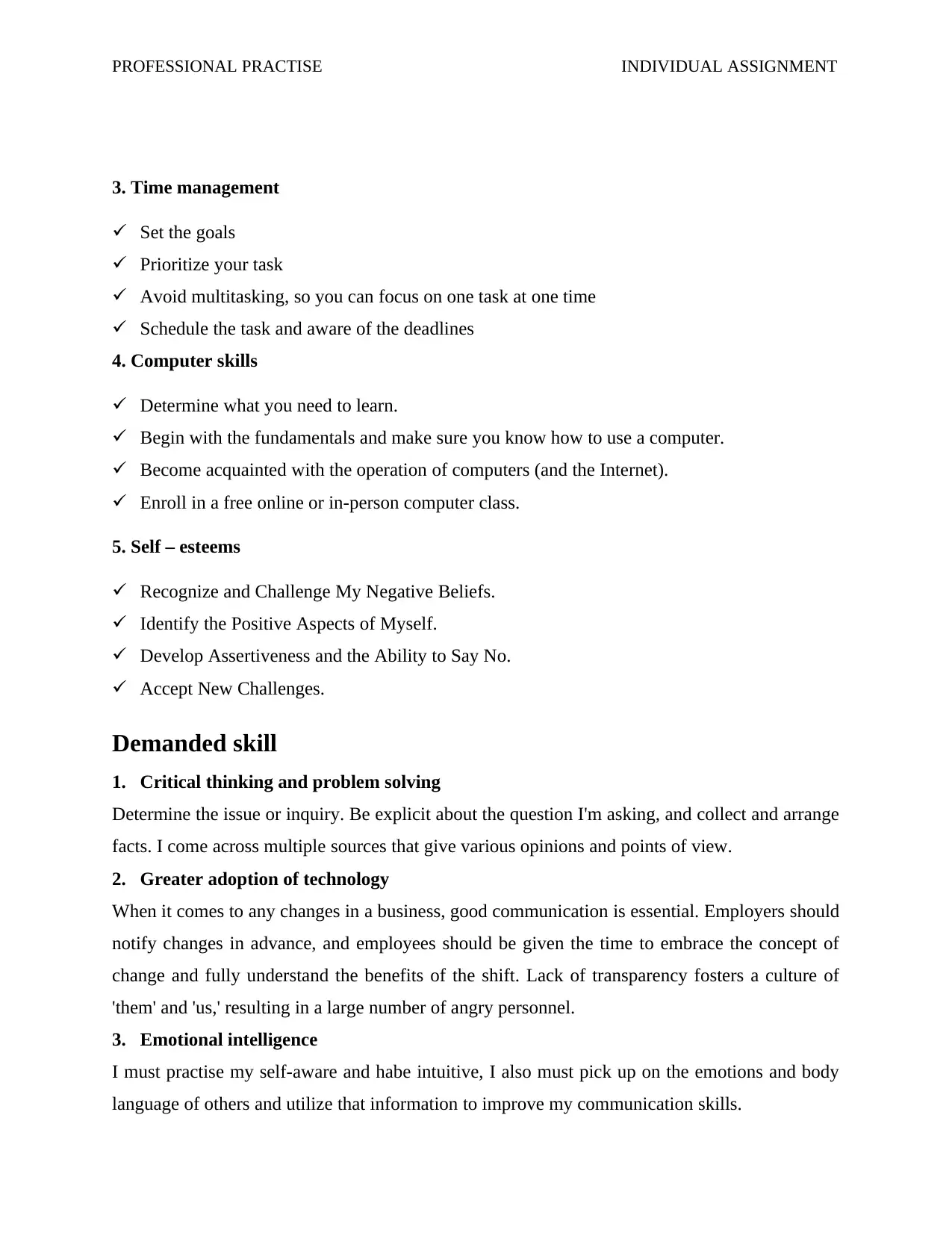
PROFESSIONAL PRACTISE INDIVIDUAL ASSIGNMENT
3. Time management
Set the goals
Prioritize your task
Avoid multitasking, so you can focus on one task at one time
Schedule the task and aware of the deadlines
4. Computer skills
Determine what you need to learn.
Begin with the fundamentals and make sure you know how to use a computer.
Become acquainted with the operation of computers (and the Internet).
Enroll in a free online or in-person computer class.
5. Self – esteems
Recognize and Challenge My Negative Beliefs.
Identify the Positive Aspects of Myself.
Develop Assertiveness and the Ability to Say No.
Accept New Challenges.
Demanded skill
1. Critical thinking and problem solving
Determine the issue or inquiry. Be explicit about the question I'm asking, and collect and arrange
facts. I come across multiple sources that give various opinions and points of view.
2. Greater adoption of technology
When it comes to any changes in a business, good communication is essential. Employers should
notify changes in advance, and employees should be given the time to embrace the concept of
change and fully understand the benefits of the shift. Lack of transparency fosters a culture of
'them' and 'us,' resulting in a large number of angry personnel.
3. Emotional intelligence
I must practise my self-aware and habe intuitive, I also must pick up on the emotions and body
language of others and utilize that information to improve my communication skills.
3. Time management
Set the goals
Prioritize your task
Avoid multitasking, so you can focus on one task at one time
Schedule the task and aware of the deadlines
4. Computer skills
Determine what you need to learn.
Begin with the fundamentals and make sure you know how to use a computer.
Become acquainted with the operation of computers (and the Internet).
Enroll in a free online or in-person computer class.
5. Self – esteems
Recognize and Challenge My Negative Beliefs.
Identify the Positive Aspects of Myself.
Develop Assertiveness and the Ability to Say No.
Accept New Challenges.
Demanded skill
1. Critical thinking and problem solving
Determine the issue or inquiry. Be explicit about the question I'm asking, and collect and arrange
facts. I come across multiple sources that give various opinions and points of view.
2. Greater adoption of technology
When it comes to any changes in a business, good communication is essential. Employers should
notify changes in advance, and employees should be given the time to embrace the concept of
change and fully understand the benefits of the shift. Lack of transparency fosters a culture of
'them' and 'us,' resulting in a large number of angry personnel.
3. Emotional intelligence
I must practise my self-aware and habe intuitive, I also must pick up on the emotions and body
language of others and utilize that information to improve my communication skills.
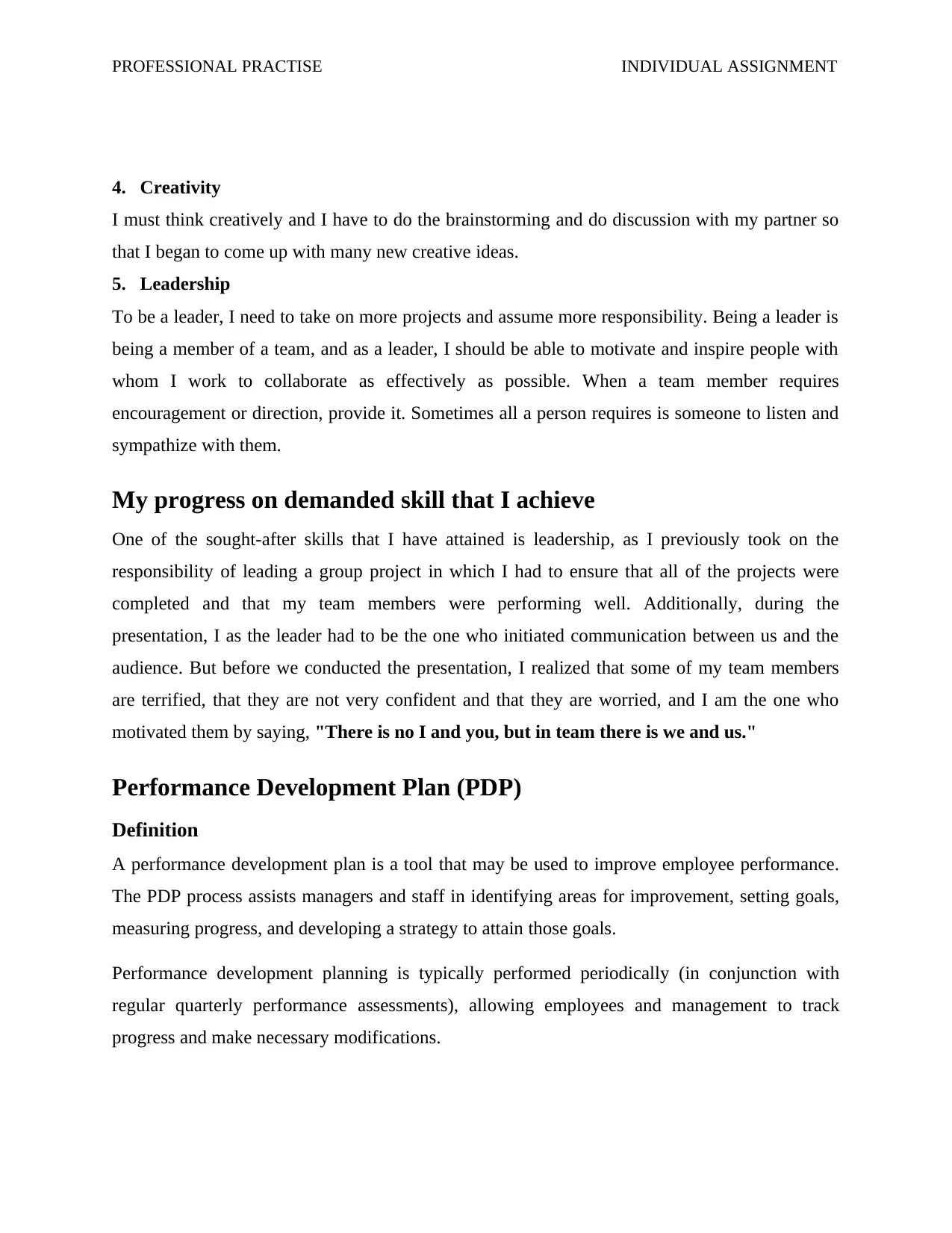
PROFESSIONAL PRACTISE INDIVIDUAL ASSIGNMENT
4. Creativity
I must think creatively and I have to do the brainstorming and do discussion with my partner so
that I began to come up with many new creative ideas.
5. Leadership
To be a leader, I need to take on more projects and assume more responsibility. Being a leader is
being a member of a team, and as a leader, I should be able to motivate and inspire people with
whom I work to collaborate as effectively as possible. When a team member requires
encouragement or direction, provide it. Sometimes all a person requires is someone to listen and
sympathize with them.
My progress on demanded skill that I achieve
One of the sought-after skills that I have attained is leadership, as I previously took on the
responsibility of leading a group project in which I had to ensure that all of the projects were
completed and that my team members were performing well. Additionally, during the
presentation, I as the leader had to be the one who initiated communication between us and the
audience. But before we conducted the presentation, I realized that some of my team members
are terrified, that they are not very confident and that they are worried, and I am the one who
motivated them by saying, "There is no I and you, but in team there is we and us."
Performance Development Plan (PDP)
Definition
A performance development plan is a tool that may be used to improve employee performance.
The PDP process assists managers and staff in identifying areas for improvement, setting goals,
measuring progress, and developing a strategy to attain those goals.
Performance development planning is typically performed periodically (in conjunction with
regular quarterly performance assessments), allowing employees and management to track
progress and make necessary modifications.
4. Creativity
I must think creatively and I have to do the brainstorming and do discussion with my partner so
that I began to come up with many new creative ideas.
5. Leadership
To be a leader, I need to take on more projects and assume more responsibility. Being a leader is
being a member of a team, and as a leader, I should be able to motivate and inspire people with
whom I work to collaborate as effectively as possible. When a team member requires
encouragement or direction, provide it. Sometimes all a person requires is someone to listen and
sympathize with them.
My progress on demanded skill that I achieve
One of the sought-after skills that I have attained is leadership, as I previously took on the
responsibility of leading a group project in which I had to ensure that all of the projects were
completed and that my team members were performing well. Additionally, during the
presentation, I as the leader had to be the one who initiated communication between us and the
audience. But before we conducted the presentation, I realized that some of my team members
are terrified, that they are not very confident and that they are worried, and I am the one who
motivated them by saying, "There is no I and you, but in team there is we and us."
Performance Development Plan (PDP)
Definition
A performance development plan is a tool that may be used to improve employee performance.
The PDP process assists managers and staff in identifying areas for improvement, setting goals,
measuring progress, and developing a strategy to attain those goals.
Performance development planning is typically performed periodically (in conjunction with
regular quarterly performance assessments), allowing employees and management to track
progress and make necessary modifications.
Secure Best Marks with AI Grader
Need help grading? Try our AI Grader for instant feedback on your assignments.
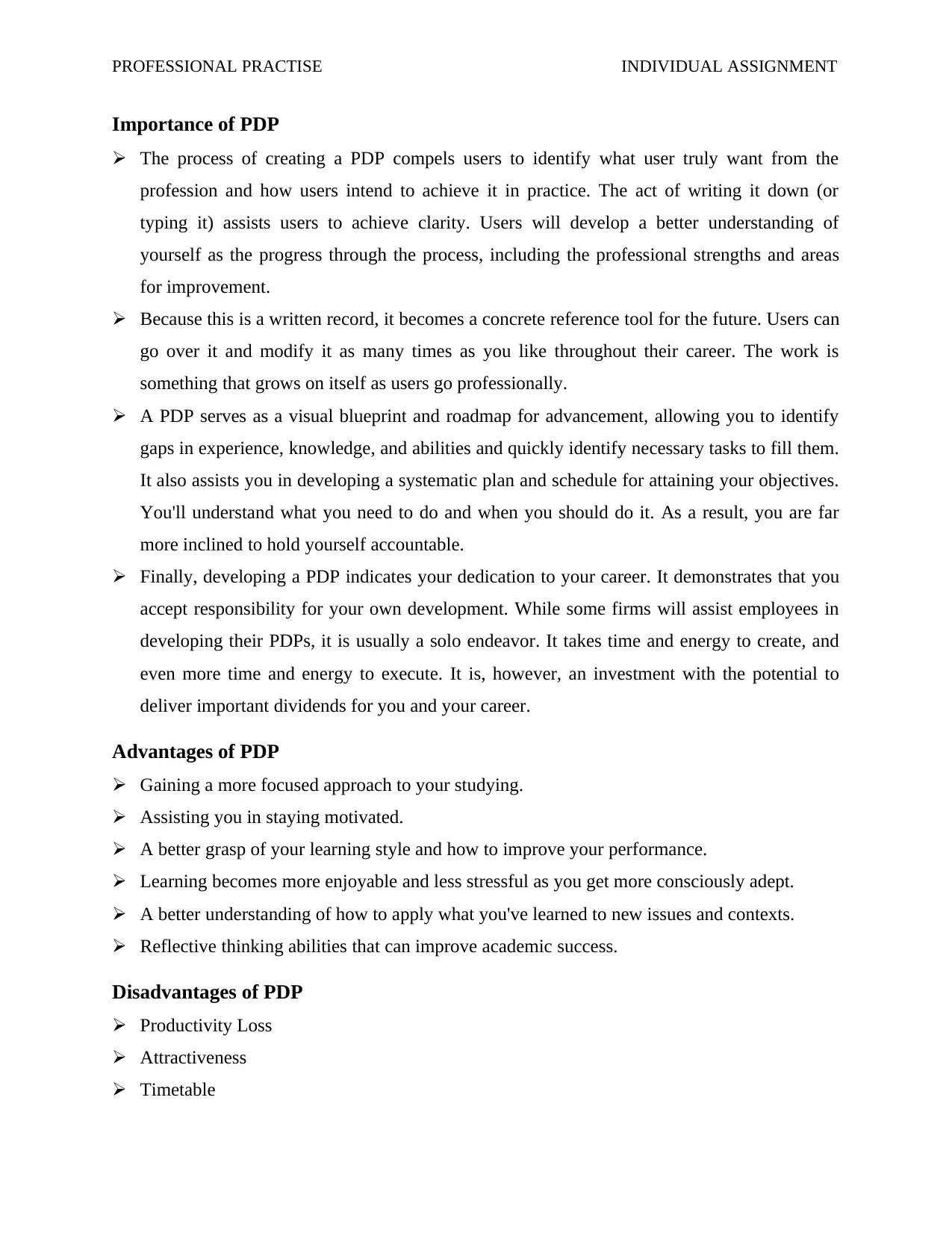
PROFESSIONAL PRACTISE INDIVIDUAL ASSIGNMENT
Importance of PDP
The process of creating a PDP compels users to identify what user truly want from the
profession and how users intend to achieve it in practice. The act of writing it down (or
typing it) assists users to achieve clarity. Users will develop a better understanding of
yourself as the progress through the process, including the professional strengths and areas
for improvement.
Because this is a written record, it becomes a concrete reference tool for the future. Users can
go over it and modify it as many times as you like throughout their career. The work is
something that grows on itself as users go professionally.
A PDP serves as a visual blueprint and roadmap for advancement, allowing you to identify
gaps in experience, knowledge, and abilities and quickly identify necessary tasks to fill them.
It also assists you in developing a systematic plan and schedule for attaining your objectives.
You'll understand what you need to do and when you should do it. As a result, you are far
more inclined to hold yourself accountable.
Finally, developing a PDP indicates your dedication to your career. It demonstrates that you
accept responsibility for your own development. While some firms will assist employees in
developing their PDPs, it is usually a solo endeavor. It takes time and energy to create, and
even more time and energy to execute. It is, however, an investment with the potential to
deliver important dividends for you and your career.
Advantages of PDP
Gaining a more focused approach to your studying.
Assisting you in staying motivated.
A better grasp of your learning style and how to improve your performance.
Learning becomes more enjoyable and less stressful as you get more consciously adept.
A better understanding of how to apply what you've learned to new issues and contexts.
Reflective thinking abilities that can improve academic success.
Disadvantages of PDP
Productivity Loss
Attractiveness
Timetable
Importance of PDP
The process of creating a PDP compels users to identify what user truly want from the
profession and how users intend to achieve it in practice. The act of writing it down (or
typing it) assists users to achieve clarity. Users will develop a better understanding of
yourself as the progress through the process, including the professional strengths and areas
for improvement.
Because this is a written record, it becomes a concrete reference tool for the future. Users can
go over it and modify it as many times as you like throughout their career. The work is
something that grows on itself as users go professionally.
A PDP serves as a visual blueprint and roadmap for advancement, allowing you to identify
gaps in experience, knowledge, and abilities and quickly identify necessary tasks to fill them.
It also assists you in developing a systematic plan and schedule for attaining your objectives.
You'll understand what you need to do and when you should do it. As a result, you are far
more inclined to hold yourself accountable.
Finally, developing a PDP indicates your dedication to your career. It demonstrates that you
accept responsibility for your own development. While some firms will assist employees in
developing their PDPs, it is usually a solo endeavor. It takes time and energy to create, and
even more time and energy to execute. It is, however, an investment with the potential to
deliver important dividends for you and your career.
Advantages of PDP
Gaining a more focused approach to your studying.
Assisting you in staying motivated.
A better grasp of your learning style and how to improve your performance.
Learning becomes more enjoyable and less stressful as you get more consciously adept.
A better understanding of how to apply what you've learned to new issues and contexts.
Reflective thinking abilities that can improve academic success.
Disadvantages of PDP
Productivity Loss
Attractiveness
Timetable
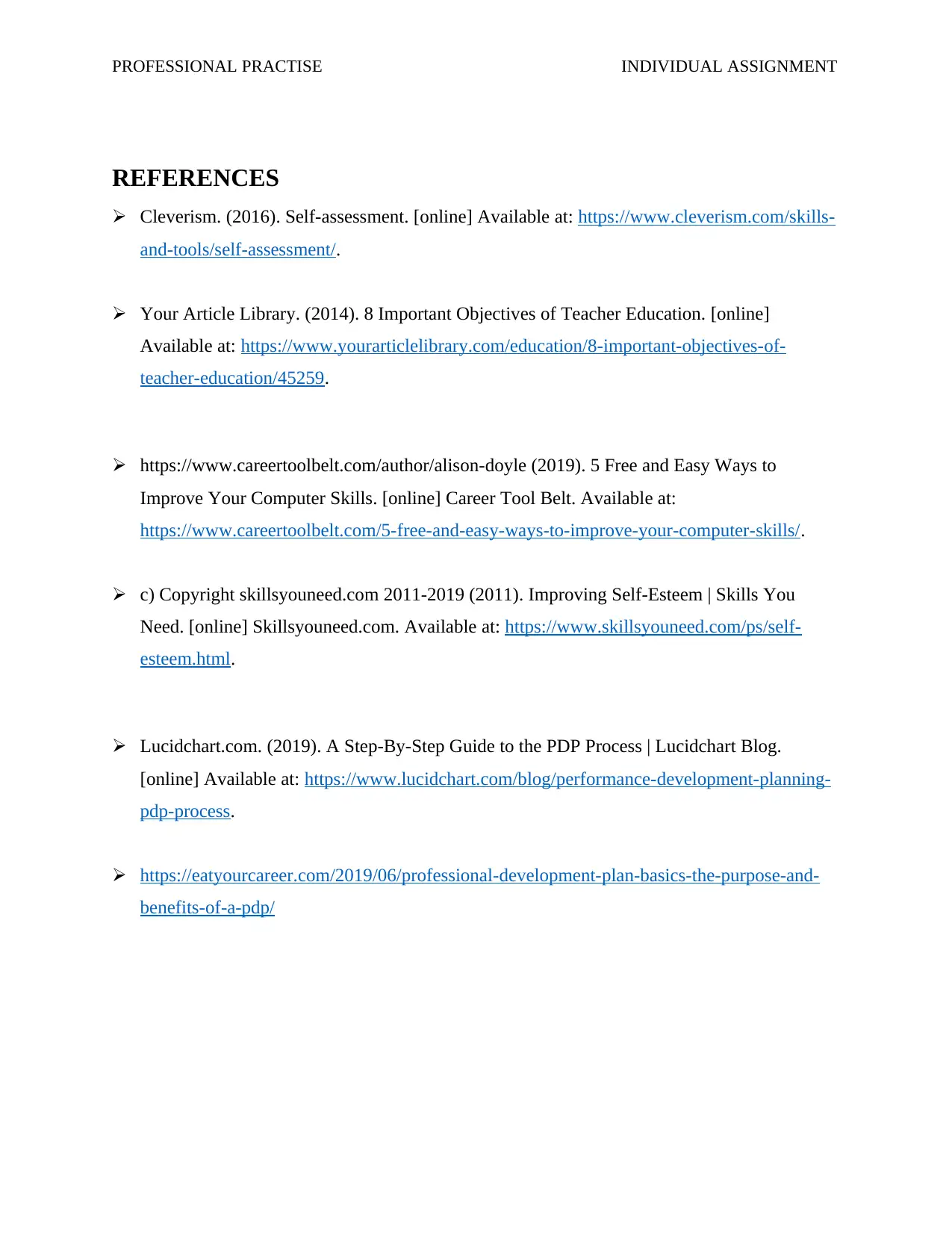
PROFESSIONAL PRACTISE INDIVIDUAL ASSIGNMENT
REFERENCES
Cleverism. (2016). Self-assessment. [online] Available at: https://www.cleverism.com/skills-
and-tools/self-assessment/.
Your Article Library. (2014). 8 Important Objectives of Teacher Education. [online]
Available at: https://www.yourarticlelibrary.com/education/8-important-objectives-of-
teacher-education/45259.
https://www.careertoolbelt.com/author/alison-doyle (2019). 5 Free and Easy Ways to
Improve Your Computer Skills. [online] Career Tool Belt. Available at:
https://www.careertoolbelt.com/5-free-and-easy-ways-to-improve-your-computer-skills/.
c) Copyright skillsyouneed.com 2011-2019 (2011). Improving Self-Esteem | Skills You
Need. [online] Skillsyouneed.com. Available at: https://www.skillsyouneed.com/ps/self-
esteem.html.
Lucidchart.com. (2019). A Step-By-Step Guide to the PDP Process | Lucidchart Blog.
[online] Available at: https://www.lucidchart.com/blog/performance-development-planning-
pdp-process.
https://eatyourcareer.com/2019/06/professional-development-plan-basics-the-purpose-and-
benefits-of-a-pdp/
REFERENCES
Cleverism. (2016). Self-assessment. [online] Available at: https://www.cleverism.com/skills-
and-tools/self-assessment/.
Your Article Library. (2014). 8 Important Objectives of Teacher Education. [online]
Available at: https://www.yourarticlelibrary.com/education/8-important-objectives-of-
teacher-education/45259.
https://www.careertoolbelt.com/author/alison-doyle (2019). 5 Free and Easy Ways to
Improve Your Computer Skills. [online] Career Tool Belt. Available at:
https://www.careertoolbelt.com/5-free-and-easy-ways-to-improve-your-computer-skills/.
c) Copyright skillsyouneed.com 2011-2019 (2011). Improving Self-Esteem | Skills You
Need. [online] Skillsyouneed.com. Available at: https://www.skillsyouneed.com/ps/self-
esteem.html.
Lucidchart.com. (2019). A Step-By-Step Guide to the PDP Process | Lucidchart Blog.
[online] Available at: https://www.lucidchart.com/blog/performance-development-planning-
pdp-process.
https://eatyourcareer.com/2019/06/professional-development-plan-basics-the-purpose-and-
benefits-of-a-pdp/
1 out of 18
Related Documents
Your All-in-One AI-Powered Toolkit for Academic Success.
+13062052269
info@desklib.com
Available 24*7 on WhatsApp / Email
![[object Object]](/_next/static/media/star-bottom.7253800d.svg)
Unlock your academic potential
© 2024 | Zucol Services PVT LTD | All rights reserved.





